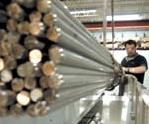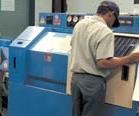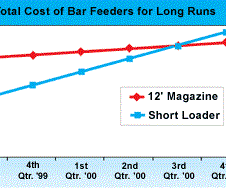The Long And Short Of Bar Feeder Selection
For many shops, the decision comes down to a 4- or 12-foot-capacity magazine-style bar feeder. Here are some guidelines for choosing between them.
You’ve bought a new, state-of-the-art, umpteen-axis CNC bar machine, or you’re planning to, and you want to pair it with a bar feeder that will allow you to fully exploit its productivity. Odds are better than 7 in 10 that you will buy a magazine-style, automatic-loading bar feeder. But should you buy a full-size bar feeder capable of feeding 12-foot-long bars to the lathe, or should you buy a more compact, “spindle-length” bar feeder designed to feed 2-, 3- and 4-foot lengths of bar to the lathe?
We estimate that short bar feeders are the most popular type, accounting for about half of all bar feeders sold in the United States and about 35 percent of total dollar sales. Full-size magazine-style bar feeders account for about 30 percent of total unit sales in the United States and about 35 percent of total dollar sales. The numbers are different in Europe, where full-size bar feeders are the rule, and short bar feeders are comparatively rare. The numbers may be interesting but, unfortunately, they cannot help you make your decision. Your run sizes, part diameters, types of materials, accuracy requirements, ability to run machines unattended, and a number of like considerations, must determine the type of bar feeder that is best for your shop. Each type has unique advantages, and you must weigh both against your shop’s particular needs. Here are some things you may want to consider when making the choice.
Production Quantities
What lot sizes will typically be run on the lathe? If production quantities are large, and productivity and getting the most pieces from the bar are important, the new lathe owner will probably benefit more from the 12-foot-capacity magazine-style bar feeder. From the standpoint of productivity, using long bars can help reduce labor costs because the machine can be left unattended for longer periods. One operator can tend two or three such machines. There is less likelihood that the machines will run out of material and be idled 10 minutes here, 15 minutes there and so on.
If the new CNC lathe will be used primarily for short-run work with frequent setup changes, the spindle-length bar feeder is the more logical choice. On such bar feeders, the entire length of the bar is fed into the lathe spindle at the onset. Because the bar neither rotates within nor is supported by the bar feeder, changing over to a different stock diameter can be done faster and easier than on the full-size bar feeder.
When the bar is 2.5 inches or more in diameter, controlling such a rotating mass in a full length bar feeder becomes a problem. In such cases, spindle-length bar feeders deserve a lot of consideration because the shorter bar is completely contained in the lathe spindle during machining, eliminating the possibility of whip and vibration. The smoother, more controlled rotation of the bar enables the lathe to run at higher rpm for faster machining. Dimensional accuracy and surface finish of the turned parts and tool life all improve when vibration is reduced.
There are instances, however, where the short bar feeder can be the right choice for a large run. Cases in point are extruded materials, such as hex bar, for which straightness can be a problem. When short lengths of such materials are completely contained in the lathe spindle, they can be rotated at high rpm for machining—without the vibration problems that could occur if fed by a full-size bar feeder. In general, the short bar feeder is more forgiving of unbalanced (non-symmetrical extrusions), bent or bowed bars that would otherwise cause vibration.
Material Utilization
Where maximum material utilization is important, the 12-foot-capacity bar feeder is a good choice because the entire bar is converted to usable parts except for a single, small remnant. By contrast, when a 12-foot-long bar is cut into three or four lengths that will be loaded in a spindle-length bar feeder, an equivalent number of remnants is produced, which means fewer parts per 12-foot bar and more scrap.
And as the cost of the material—stainless steel, titanium, brass and so forth—being machined increases, reducing scrap becomes even more important. Manufacturers who invest in plants and equipment to make scrap will find it increasingly difficult to compete against firms that are investing in plants and equipment to make parts.
Lathe Spindle Length
The length of the lathe spindle is not a factor when considering a 12-foot-capacity bar feeder. However, it cannot be ignored when considering the spindle-length bar feeder. Many CNC bar machines have spindles into which short bars up to 4 feet long can be completely inserted. Such lathes can accommodate 3- and 4-foot lengths cut from standard 12-foot bars. As was mentioned earlier, material loss to remnants from the short bars is several times greater than the loss from a continuous 12-foot bar but may be acceptable, for example, for prototypes and short-run jobs.
However, the trend in today’s lathes is for shorter spindles—as short as 2 feet for some models. In such cases, 12-foot bars must be cut into 2-foot lengths, creating six times as many remnants as a continuous bar. Material utilization may worsen to such an extent that the shop owner cannot use a spindle-length bar feeder for such a job and remain competitive.
Part Length
The 12-foot magazine-style bar feeder typically delivers better material utilization than the spindle-length bar feeder. Regardless of part length, material loss from a continuous 12-foot bar is limited to one remnant. However, as part length increases on a lathe served by a spindle-length bar feeder, the remnants left from each of three or four short lengths cut from a continuous 12-foot bar can represent a significant percentage of the bar.
If the job involves washer-like parts, a 3-foot bar may last for an hour. However, if the job involves motor shafts, the lathe can go through a 3-foot bar in as many minutes, and then it must pause while the next short bar is loaded. The amount of time it takes for the short bar feeder to load the short lengths of bar into the lathe can drag down production rates for the part as well.
Unattended Operation
Thinking of running your CNC bar machines unattended overnight, during holidays, over weekends? Running unattended imposes a number of special requirements, not the least of which is the ability to supply the machine with enough raw material to continue running for the intended period. The amount of time the lathe can run unattended, assuming all other systems are functioning properly, depends on how much material the bar feeder’s magazine can hold.
The gravity rack of a short bar feeder can accommodate a 30-inch-wide row of 36- to 48-inch long bars. For 1-inch-diameter bar, that translates to 90 to 120 linear feet of bar that can be banked in the short bar feeder for machining.
By comparison, the standard gravity rack on most 12-foot bar feeders is 12 inches. For 12-foot-long, 1-inch-diameter bars, that translates to 144 linear feet ready for machining. Use of 14-, 16-, 18- or 20-foot-long bars instead of 12-foot bars increases the capacity proportionately. And that’s just the start. Extended bar racks are available up to 70 inches, which for 12-foot-long, 1-inch-diameter bars translates to 840 linear feet of bar capacity. Also, bundle bar feeders can accept bundles of bars weighing up to 2 tons. One company loads bundles containing as many as 500 20-foot-long bars at a time into multiple bundle bar feeders. Clearly, in applications where the need is to provide enough bar capacity to allow a lathe to run unattended for an entire shift or longer, full-length bar feeders have the edge.
Floor Space
In situations where floor space is at a premium, the spindle-length bar feeder is usually preferred since it only takes up about half of the space required for a 12-foot-capacity bar feeder. The savings in floor space may not be that great for a single bar feeder, but where a multiple-machine installation is involved, the space savings can frequently be enough to permit installing one or more additional lathes and bar feeders than would otherwise be possible.
Many firms that buy spindle-length bar feeders do so because they believe they do not have the room for a 12-foot-capacity bar feeder. However, bar feeder suppliers make the point that once prospective buyers calculate the advantages of the 12-foot-capacity bar feeder over the spindle-length bar feeder in terms of productivity gains and increased material utilization, they somehow find the room for the larger unit.
RPM
Historically, shops that operated bar machines had a problem controlling the whip and vibration that occur in a long bar when it is rotated at high speed. The main causes of the problem have included the difficulty of controlling a closely confined bar rotating at speeds of up to 10,000 rpm and the lack of uniformity in the bar material itself. Ironically, while lathe builders have been increasing the spindle speeds of their machines to improve productivity, shop owners had to cut back on spindle speed to minimize the effects of vibration on such things as accuracy, surface finish and tool life.
Today the situation is much improved. Better bar feeder design plus more widespread use of centerless ground bar stock have made it possible for 12-foot-capacity bar feeders to feed 12-foot bars up to 2 inches in diameter at or near maximum spindle speeds. Users of such bar feeders no longer have to sacrifice spindle speed to get productivity with good material utilization.
For bar stock over 2.5 inches in diameter, the spindle-length bar feeder is the better choice because it feeds the entire piece of bar into the lathe spindle where it usually can be rotated at or near maximum spindle speed without vibration.
Cost is also a factor. A 12-foot-capacity bar feeder capable of handling bar stock larger than 2 inches in diameter costs more than models made for smaller diameters. By contrast, the spindle-length bar feeder can easily accommodate the larger-diameter bar stock, so the savings by purchasing the spindle-length bar feeder instead of a 12-foot-capacity bar feeder becomes greater.
Changeover Time
The amount of time required to change over the bar feeder to feed a different bar diameter is another important consideration. The spindle-length bar feeder has the edge here because of its simpler operation. Typically, the spindle-length bar feeder can be changed over to run a different bar diameter in 10 to 15 minutes, assuming the correctly sized spindle liner is available. Most of that time is taken up in removing the liner from the lathe spindle and replacing it with one that more closely matches the diameter of the bar stock for the next job.
The fast changeover time of the spindle-length bar feeder is an important advantage for shops that do a lot of short-run work. The short bar lengths are lighter, less awkward and less fatiguing to handle than 12-foot bars, which also helps speed the changeover.
Changing from one bar diameter to another on a 12-foot magazine-style bar feeder can take from 45 minutes on older units to as little as 20 minutes on newer units. Changeover time depends primarily on whether or not the guide channel, which supports and confines the bar as it rotates in the bar feeder, needs to be changed. If the bar size for the next job to be run is very similar to that for the job just finishing, the same guide channel may be used, shortening the setup time. If the guide channel must be changed, the setup can take twice as long.
To minimize downtime due to setup changes, many shops dedicate each of their machines to a guide channel diameter size range and assign jobs accordingly. The arrangement helps to reduce down time by reducing bar feeder adjustments caused by changes to a different bar diameter. Also, some bar feeder manufacturers offer quick-bar-change features on their 12-foot-capacity units that permit changeovers in 15 to 20 minutes.
People Issues
Shops need to get the most from their employees. That includes providing an environment that keeps employees interested in their work and minimizes the potential for injuries on the job. Since less manual bar handling is involved in using full-length, magazine-style bar feeders, operators have fewer smashed fingers, strained backs and similar injuries. In fact, with today’s bundle loaders, a 5,000-pound bundle of bars can be delivered by overhead crane directly to the bar feeder and never touched by shop personnel. That frees operators for more productive tasks such as running several machines and monitoring part quality.
Total Costs
For shops that have a number of short-run jobs and need to be able to accommodate a wide range of part diameters, the spindle-length bar feeder is a great buy at about $16,000. However, shops with high-volume jobs where good production rates and low scrap ratios are essential to maintain competitive pricing will find the 12-foot-capacity magazine-style bar feeder an even better bargain at about $30,000.
Obviously, a shop can use the spindle-length bar feeder for high-volume work—many do—perhaps on the theory that the savings on the purchase price more than makes up for a little less yield per 12-foot bar and a slightly slower production rate. As the graph above shows, when a spindle-length bar feeder is used for high-volume work, the total cost of using it for that purpose becomes the same as if the shop had purchased a 12-foot-capacity bar feeder. However, where the total cost of owning the 12-foot-capacity bar feeder rises slowly, the cost of owning the “less expensive” short bar feeder catches up in a year’s time and then becomes greater.
Your Choice
If you are one of the many shops planning to buy a magazine-style bar feeder soon, we hope we have given you enough information to correctly choose between a spindle-length bar feeder and a 12-foot-capacity bar feeder. And if this article comes a month or two too late for some of you, we hope that the foregoing confirms the wisdom of your choice.
— Bucci Industries USA
Related Content
Inside the Premium Machine Shop Making Fasteners
AMPG can’t help but take risks — its management doesn’t know how to run machines. But these risks have enabled it to become a runaway success in its market.
Read MoreUnattended Production Takes More Than the Most Capable CNC Machine
Process planning and reliable peripherals are key to successful lights-out manufacturing.
Read MoreAutomation Breakthroughs Revolutionize Precision Machining for Complex Parts
Marubeni Citizen-Cincom delivers custom solutions to address some of the biggest challenges in precision machining from handling small parts, to robot integration and unique tooling needs.
Read MoreAutomation Idea for Halloween?
Maybe not. But, the candy-throwing robots at MetalQuest’s Nebraska facility do enable the contract machine shop to stand out at career fairs and similar events.
Read MoreRead Next
Do You Have Single Points of Failure?
Plans need to be in place before a catastrophic event occurs.
Read More5 Aspects of PMTS I Appreciate
The three-day edition of the 2025 Precision Machining Technology Show kicks off at the start of April. I’ll be there, and here are some reasons why.
Read MoreA Tooling Workshop Worth a Visit
Marubeni Citizen-Cincom’s tooling and accessory workshop offers a chance to learn more about ancillary devices that can boost machining efficiency and capability.
Read More


















.jpg;maxWidth=300;quality=90)







